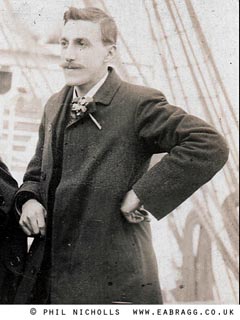 Photographer Edward Bragg may be elusive as far as personal records go but across the decade before he went to war he created a wealth of images documenting our peninsula.
Photographer Edward Bragg may be elusive as far as personal records go but across the decade before he went to war he created a wealth of images documenting our peninsula.
This month, with February 1st being the centenary of the wreck of the German barque Hera I’m looking at a few of his wreck related images and occasional insights into events recorded by local people who bought his photo-cards, scrawled (usually) hasty messages on the reverse and mailed them to friends and family.
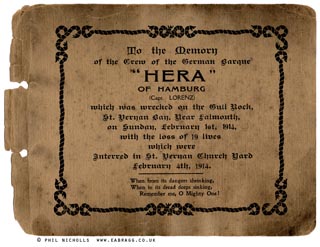
Hand printing his photographs and selling them as real-photo postcards he created a perfect medium for recording some great insights of day-to-day life of the period. These photo-cards were the swift way to communicate as there were regular postal collections and deliveries each day. Not only did folk openly enquire after each other’s health, send romantic messages, swap new views as they became available but also described in detail events such as these shipwrecks.
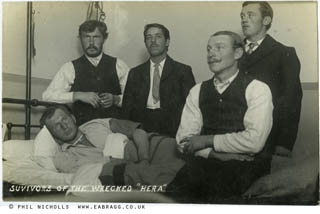 My Great-Aunt, Rhoda Moyle remembered having a half-day off school to see The Gustav, swept ashore at Porthcurnick Beach, Portscatho on January 16th 1912. This is echoed by a witness to the event who wrote on the reverse of one Gustav image by Bragg. It reads;
My Great-Aunt, Rhoda Moyle remembered having a half-day off school to see The Gustav, swept ashore at Porthcurnick Beach, Portscatho on January 16th 1912. This is echoed by a witness to the event who wrote on the reverse of one Gustav image by Bragg. It reads;
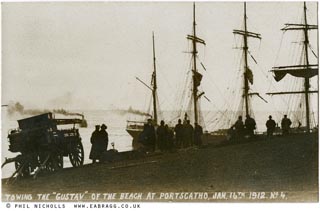 ‘Dear Lily, this is the ship that caused so much excitement here last Saturday, it was a thing never to be forgotten. All the school children had a half-day holiday and went over (to Porthcurnick) to help pull the ropes.
‘Dear Lily, this is the ship that caused so much excitement here last Saturday, it was a thing never to be forgotten. All the school children had a half-day holiday and went over (to Porthcurnick) to help pull the ropes.
Ten of the crew landed, came over to the Public Hall and had coffee and eatables – Mrs Rainbach had 2 legs of mutton roasted and had them all to dinner.
Not much work work was done here that morning until they left here at about 2.00pm’
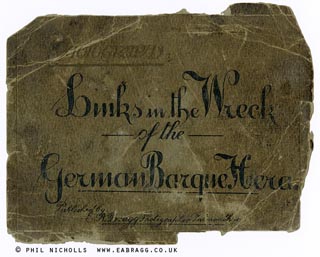 Edward Bragg photographed some of the crew, we can clearly picture them, but who was Mrs Rainbach? I can’t find her locally in the census of 1911 but I believe she appears as a visitor to the village in that of 1901; Mrs Kate Rainbach, age 36, married and from London. I wonder, who was this Good Samaritan?
Edward Bragg photographed some of the crew, we can clearly picture them, but who was Mrs Rainbach? I can’t find her locally in the census of 1911 but I believe she appears as a visitor to the village in that of 1901; Mrs Kate Rainbach, age 36, married and from London. I wonder, who was this Good Samaritan?
The sender of a message on another Gustav image, sent from Trewithian post office to London on January 18th 1912, exclaims ‘Who would not live in Portscatho in this stirring time of wrecks?
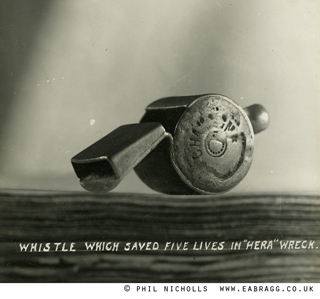 Turn-around of photo-cards for sale was swift, the above-mentioned card with note being sent two days after the event. Competition between photographers was fierce especially in the towns; in outlying areas it was swift production that counted. Bragg seems to have had little real competition on The Roseland during his working period and must have dashed back to Falmouth to make his prints. Covering events such as ‘Rocket Practice at Portscatho’, taken around the time of the foundering of the Gustav, he would return to make local sales and perhaps leave batches at the post offices.
Turn-around of photo-cards for sale was swift, the above-mentioned card with note being sent two days after the event. Competition between photographers was fierce especially in the towns; in outlying areas it was swift production that counted. Bragg seems to have had little real competition on The Roseland during his working period and must have dashed back to Falmouth to make his prints. Covering events such as ‘Rocket Practice at Portscatho’, taken around the time of the foundering of the Gustav, he would return to make local sales and perhaps leave batches at the post offices.

My interest is in the life and business of a photographer at the beginning of the Twentieth Century, the product itself and how it was created. With the centenary of the Hera tragedy in mind I’ve included some related examples of Bragg’s work. The loss of the Hera led to him creating a booklet in which he pasted large prints, each with a pinhole in the corner where it was held up to dry, it includes what he calls ‘Links’ in the story of the ship.
 He photographs the site of the wreck at Gull Rock in Gerrans Bay, the attendant lifeboats, wreckage on the shore, survivors and a very contemporary image of ‘The Whistle That Saved Five Lives’. He includes photographs of Veryan Church, the funeral and grave of the nineteen men who were lost. A set of postcards of many of these images was created and sold on The Roseland too, a grim memento of the tragedy.
He photographs the site of the wreck at Gull Rock in Gerrans Bay, the attendant lifeboats, wreckage on the shore, survivors and a very contemporary image of ‘The Whistle That Saved Five Lives’. He includes photographs of Veryan Church, the funeral and grave of the nineteen men who were lost. A set of postcards of many of these images was created and sold on The Roseland too, a grim memento of the tragedy.
This month I haven’t said much about Edward Bragg himself but next time will relate his story to-date along with his thoughts on volunteering for the army during The First World War. As I said earlier, he left little to go on and I’m attempting to build a picture through his personal notes and photographs. I had only a single image of him until recently but believe I have found two more – a couple of prints of a figure at Carn Brea, I’m sure it’s him. That’s for next time………
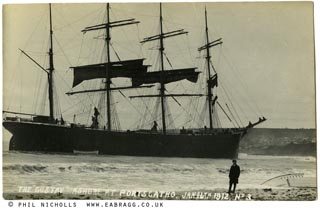 For a full collection of Hera related images visit www.eabragg.co.uk and try his facebook page (linked to the main website) for regular additions and discussions.
For a full collection of Hera related images visit www.eabragg.co.uk and try his facebook page (linked to the main website) for regular additions and discussions.
I have been asked for prints and canvases of his work and all enquiries of that nature please visit the Bragg website for information.
Phil Nicholls, February’14.
Portfolio: www.philnicholls.co.uk
Archive & print sales: www.philnicholls.com


All extremely fascinating Phil. Do you know what happened to the survivors? Have you had any contact with any of their families?
Bragg is certainly turning out to be so much more than a photographer, he shows an ability to market himself that many people today might envy. And, such a good postal service in those days!
Looking forward to more news next month.